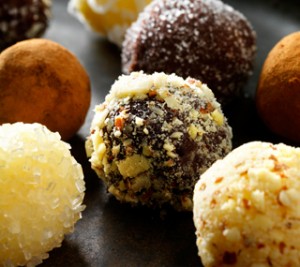
Before I even start in on this, please be aware that Lindt Chocolate is NOT gluten-free (thank you to Jill at heythattastesgood for tipping me off about that). Okay, one more time, Lindt Chocolate is not gluten-free, news that came straight from the lips of a kind lady at Lindt customer service. This post is about some interesting aspects of the business side of the company, not about their products.
If you want fun, nutritional information about chocolate, check out this post I did on the health benefits. As always, check directly with the company if you have questions regarding ingredients.
Onward . . .
Lindt Chocolate USA has a sweet way of going green. That famous gold Easter bunny is hopping on the environmental bandwagon. Lindt USA, which is located in Stratham, New Hampshire, is teaming up with the local power plant on a project to convert cocoa bean shells, a by-product of chocolate processing, into green fuel. Very cool.
As Thomas Linemayr, Lindt USA’s CEO said recently, “Not only would it be a quick, local solution for disposing of a by-product, but it would afford us another opportunity to reduce our carbon footprint…”
Lindt USA is also a committed partner with Autism Speaks, an organization bringing awareness, fundraising, science, and advocacy efforts together on behalf of children with autism. Lindt is donating a percentage of sales to this noble cause.
As many of you may know, a gluten-free/casein-free diet often helps in the treatment of autism spectrum disorder, hence my interest in the autism community. According to Autism Speaks, one in every 150 children will be diagnosed with the condition this year alone, making it the fastest growing serious developmental issue in the US.



Big, sweet kudos to Lindt USA for their concern for the environment and their support for autism research — even if their chocolate is off limits to those of us on a GF diet. Sniff, sniff.
I’m on a no-sugar binge right now so I’m going to resist experimenting with these delightful looking truffles pictured above, but here’s the recipe if you want to give it a try. Keep in mind, the chocolate indicated in the recipe is Lindt and contains gluten. Just substitute with a gluten-free version. Let me know how they turn out. Wait, on second thought, not while I’m on my no-sugar jag. Oh well, tell me anyway, I want to know. I can handle it.
Go forth and enjoy life (stinky economy or not).
Melissa














I still wish Lindt was gluten free
Argh! Why would a company partner with Autism speaks while producing a gluten-(and often dairy-)containing product!? It just doesn’t make sense. I mean, I think it’s great they are supporting autism research, but it seems funny to me they are ignoring research regarding the positive impact of a GF/CF diet, when it would be pretty easy to make their chocolate at least GF.
Sorry for the rant - I just couldn’t hold back.
Jill & Lauren,
You know, the more I think about this blog post, the more confusing it becomes.
I liked the idea of the cocoa bean shell waste being recycled into energy and then I discovered the autism support and I really liked that, but you’re both right. It is kind of odd, isn’t it? But then again, in this economy, I imagine charitable donations are greatly appreciated, regardless. I may call them and ask about that.
No need to apologize for the rant Lauren — I agree. And Jill’s the one who told me the chocolate isn’t GF. I guess with their connection to Autism Speaks, I made the assumption that it was GF. It’s not a bad thing, just an odd relationship. Maybe there’s more to it than we know.
Thanks for your help and comments!
Melissa
switching my son’s diet to gluten free diet was difficult at first but has proven to do wonders for his Autism. I was able to get a lot of great gluten free diets. Cooking to Heal bring autism nutrition education right into your own home. I really liked the 4 hours of live teaching. The instruction allowed me to clearly understand autism diets and how to cook for him.
This post is interesting on many levels. I just told my husband who works at a power plant about the cocoa bean shell to green statement. His plant is one of the cleanest coal-fired plants in the world. Their steam is piped into a neighboring greenhouse for tomatoes, flowers, or whatever is growing, at the time-42 acres under glass. The plant’s ash is made into cinderblocks.
I wish Lindt would get on the GF bandwagon, too. I agree that considering their connection with Autism Speaks, it seems odd. Of course, their chocolate will never be casein-free. Only the darkest purest chocolate is casein free, right?
I love making truffles, but I am staying off the sugar right now, too.
Shirley
Becky,
Thanks for the information. I was tempted to delete this post altogether, but decided to leave it because of the good information people were posting. Plus, I just like the idea of recycling cocoa bean waste into energy. Plus, even if Lindt doesn’t make GF candy, they are doing good deeds for he autism community.
Shirley,
Wow, very interesting. Isn’t it amazing all the great things going on in this country! People making things happen and contributing in their own ways.
As for Lindt, they’d have to have a totally separate facility to make the GF version and I doubt they want to bother with that. Most of the chocolate companies that have dedicated GF facilities are smaller outfits. Plus, you just can’t always guarantee that the ingredients you source from elsewhere are GF.
It’s not easy being gluten-free and green.
Sorry, I know that was dorky.